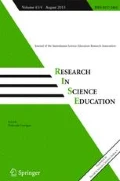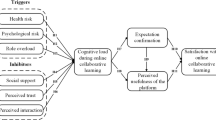Abstract
This paper describes the development, final design and validation of an instrument that measures a range of student interactions and satisfaction in undergraduate chemistry laboratories. Student surveys or conceptual and attitudinal instruments are widely used techniques for collecting relevant information on student learning. However, there is a lack of specific instruments for collecting data on the relationships between social factors and learning. Consequently, this study attempted to fill this gap by introducing an instrument—the Interactions in Undergraduate Laboratory Classes (IULC). The design of the IULC instrument is based on the theory of distributed cognition, meaning that knowledge is not rooted in an individual’s mind, but develops in the process of interacting with the environment. The instrument covers three aspects: (i) frequency of interactions, (ii) satisfaction and (iii) importance of interactions for the specific laboratory. Undergraduate students (N = 204) enrolled in a first-year chemistry course participated in a test case for the instrument and the corresponding data were analysed using different methods for each of the three parts. The factor structure of the data obtained from the first part of the instrument and internal consistency measures are discussed. Among findings captured by the instrument, student-teacher (instructors in the university context) interactions correlated positively with students’ satisfaction levels. Implications and suggestions for the use of the instrument are discussed.



Similar content being viewed by others
References
Barrie, S. C., Bucat, R. B., Buntine, M. A., Burke da Silva, K., Crisp, G. T., George, A. V., Jamie, I. M., Kable, S. H., Lim, K. F., Pyke, S. M., Read, J. R., Sharma, M. D., & Yeung, A. (2015). Development, evaluation and use of a student experience survey in undergraduate science laboratories: The advancing science by enhancing learning in the laboratory student laboratory learning experience survey. International Journal of Science Education, 37(11), 1795–1814. https://doi.org/10.1080/09500693.2015.1052585.
Bryant, F. B., Yarnold, P. R., & Michelson, E. A. (1999). Statistical methodology: VIII. Using confirmatory factor analysis (CFA) in emergency medicine research. Academic Emergency Medicine, 6(1), 54–66. https://doi.org/10.1111/j.1553-2712.1999.tb00096.x.
Cho, E., & Kim, S. (2015). Cronbach’s coefficient alpha: well known but poorly understood. Organizational Research Methods, 18(2), 207–230. https://doi.org/10.1177/1094428114555994.
Cole, M., & Engeström, Y. (1993). A cultural-historical approach to distributed cognition. In G. Salomon (Ed.), Distributed cognitions: psychological and educational considerations (pp. 1–46). New York: Cambridge University Press.
Creswell, J. W., & Creswell, J. D. (2018). Research design: qualitative, quantitative, and mixed methods approaches (5th ed.). Thousand Oaks, CA: Sage.
Gadermann, A. M., Guhn, M., & Zumbo, B. D. (2012). Estimating ordinal reliability for Likert-type and ordinal item response data: a conceptual, empirical, and practical guide. Practical Assessment, Research & Evaluation, 17 (3), 1–13 Retrieved 21 Apr 2020 from https://scholarworks.umass.edu/pare/vol17/iss1/3/. https://doi.org/10.7275/n560-j767.
Galloway, K. R., & Bretz, S. L. (2015). Development of an assessment tool to measure students’ meaningful learning in the undergraduate chemistry laboratory. Journal of Chemical Education, 92(7), 1149–1158. https://doi.org/10.1021/ed500881y.
Giere, R. N. (2011). Distributed cognition in the lab. [Science as psychology sense-making and identity in science practice, Lisa M. Osbeck, Nancy J. Nersessian, Kareen R. Malone, Wendy C. Newstetter]. Science, 333(6039), 159–160. https://doi.org/10.1126/science.1207754.
Gosling, S. D., Rentfrow, P. J., & Swann, W. B. (2003). A very brief measure of the big-five personality domains. Journal of Research in Personality, 37(6), 504–528. https://doi.org/10.1016/S0092-6566(03)00046-1.
Graham, J. M. (2006). Congeneric and (essentially) tau-equivalent estimates of score reliability: what they are and how to use them. Educational and Psychological Measurement, 66(6), 930–944. https://doi.org/10.1177/0013164406288165.
Harshman, J., & Stains, M. (2017). A review and evaluation of the internal structure and consistency of the approaches to teaching inventory. International Journal of Science Education, 39(7), 918–936. https://doi.org/10.1080/09500693.2017.1310411.
Hofstein, A., & Lunetta, V. N. (2004). The laboratory in science education: foundations for the twenty-first century. Science Education, 88(1), 28–54. https://doi.org/10.1002/sce.10106.
Hu, L. t., & Bentler, P. M. (1999). Cutoff criteria for fit indexes in covariance structure analysis: conventional criteria versus new alternatives. Structural Equation Modeling: A Multidisciplinary Journal, 6(1), 1–55. https://doi.org/10.1080/10705519909540118.
Hurley, A. E., Scandura, T. A., Schriesheim, C. A., Brannick, M. T., Seers, A., Vandenberg, R. J., & Williams, L. J. (1997). Exploratory and confirmatory factor analysis: guidelines, issues, and alternatives. Journal of Organizational Behavior, 18(6), 667–683. https://doi.org/10.1002/(SICI)1099-1379(199711)18:6<667::AID-JOB874>3.0.CO;2-T.
Komperda, R., Hosbein, K. N., & Barbera, J. (2018a). Evaluation of the influence of wording changes and course type on motivation instrument functioning in chemistry. Chemistry Education Research and Practice, 19(1), 184–198. https://doi.org/10.1039/C7RP00181A.
Komperda, R., Pentecost, T. C., & Barbera, J. (2018b). Moving beyond alpha: a primer on alternative sources of single-administration reliability evidence for quantitative chemistry education research. Journal of Chemical Education, 95(9), 1477–1491. https://doi.org/10.1021/acs.jchemed.8b00220.
Luckay, M. B., & Laugksch, R. C. (2015). The development and validation of an instrument to monitor the implementation of social constructivist learning environments in grade 9 science classrooms in South Africa. Research in Science Education, 45(1), 1–22. https://doi.org/10.1007/s11165-014-9410-5.
MacCallum, R. C., Widaman, K. F., Zhang, S., & Hong, S. (1999). Sample size in factor analysis. Psychological Methods, 4(1), 84–99. https://doi.org/10.1037/1082-989X.4.1.84.
Maor, D., & Fraser, B. J. (2005). An online questionnaire for evaluating students' and teachers' perceptions of constructivist multimedia learning environments. Research in Science Education, 35(2), 221–244. https://doi.org/10.1007/s11165-005-2148-3.
Mocerino, M., Yeo, S., & Zadnik, M. G. (2015). Enhancing students' learning in laboratories through professional development of teaching assistants. EC2E2N NewsLetter 2015 – Special Edition: Chemistry Teaching and Learning. Retrieved 22 Apr 2020 from http://chemnet.edu.au/sites/default/files/u39/Mocerino2015EC2E2Nreport_demostratortraining.pdf.
Moore, M. G. (1989). Editorial: three types of interaction. American Journal of Distance Education, 3(2), 1–7. https://doi.org/10.1080/08923648909526659.
Nakhleh, M. B., Polles, J., & Malina, E. (2002). Learning chemistry in a laboratory environment. In J. K. Gilbert, O. De Jong, R. Justi, D. F. Treagust, & J. H. Van Driel (Eds.), Chemical education: towards research-based practice (pp. 69–94). New York: Springer.
Osbeck, L. M., Nersessian, N. J., Malone, K. R., & Newstetter, W. C. (2010). Science as psychology: sense-making and identity in science practice. Cambridge University Press. https://doi.org/10.1017/CBO9780511933936.
Panizzon, D., & Levins, L. (1997). An analysis of the role of peers in supporting female students’ choices in science subjects. Research in Science Education, 27(2), 251–270. https://doi.org/10.1007/bf02461320.
Peters, G. J. Y. (2018). Userfriendlyscience: Quantitative analysis made accessible (Version R package version 0.7.2). Retrieved 22 Apr 2020 from https://userfriendlyscience.com. https://doi.org/10.1017/CBO9780511933936.
R Core Team. (2018). R: A language and environment for statistical computing. Vienna: R Foundation for Statistical Computing Retrieved 22 Apr 2020 from https://www.R-project.org/.
Sadler, T. D., Puig, A., & Trutschel, B. K. (2011). Laboratory instructional practices inventory: a tool for assessing the transformation of undergraduate laboratory instruction. Journal of College Science Teaching, 41(1), 25–31 Retrieved 22 Apr 2020 from http://www.jstor.org/stable/43748279. https://doi.org/10.1112/plms/pdt049.
Stang, J. B., & Roll, I. (2014). Interactions between teaching assistants and students boost engagement in physics labs. Physical Review Special Topics - Physics Education Research, 10(2), 020117. https://doi.org/10.1103/PhysRevSTPER.10.020117.
Sutton, L. A. (2001). The principle of vicarious interaction in computer-mediated communications. International Journal of Educational Telecommunications, 7(3), 223–242 Retrieved 22 Apr 2020 from https://www.learntechlib.org/primary/p/9534/.
Taherdoost, H., Sahibuddin, S., & Jalaliyoon, N. (2014). Exploratory factor analysis: concepts and theory. In J. Balicki (Ed.), Advances in applied and pure mathematics (pp. 375–382). Gdansk: WSEAS Press.
Tsai, C.-C. (2003). Taiwanese science students' and teachers' perceptions of the laboratory learning environments: exploring epistemological gaps. International Journal of Science Education, 25(7), 847–860. https://doi.org/10.1080/09500690305031.
Uzuntiryaki, E., & Çapa Aydın, Y. (2009). Development and validation of Chemistry Self-Efficacy Scale for college students. Research in Science Education, 39(4), 539–551. https://doi.org/10.1007/s11165-008-9093-x.
Velasco, J. B., Knedeisen, A., Xue, D., Vickrey, T. L., Abebe, M., & Stains, M. (2016). Characterizing instructional practices in the laboratory: the laboratory observation protocol for undergraduate STEM. Journal of Chemical Education, 93(7), 1191–1203. https://doi.org/10.1021/acs.jchemed.6b00062.
Wei, J., Mocerino, M., Treagust, D. F., Lucey, A. D., Zadnik, M. G., Lindsay, E. D., & Carter, D. J. (2018). Developing an understanding of undergraduate student interactions in chemistry laboratories. Chemistry Education Research and Practice, 19, 1186–1198. https://doi.org/10.1039/C8RP00104A.
Wei, J., Treagust, D. F., Mocerino, M., Lucey, A. D., Zadnik, M. G., & Lindsay, E. D. (2019). Understanding interactions in face-to-face and remote undergraduate science laboratories: a literature review. Disciplinary and Interdisciplinary Science Education Research, 1(1), 14. https://doi.org/10.1186/s43031-019-0015-8.
West, E. A., Paul, C. A., Webb, D., & Potter, W. H. (2013). Variation of instructor-student interactions in an introductory interactive physics course. Physical Review Special Topics - Physics Education Research, 9(1), 010109.
Williams, B., Onsman, A., & Brown, T. (2010). Exploratory factor analysis: a five-step guide for novices. Australasian Journal of Paramedicine, 8(3). https://doi.org/10.33151/ajp.8.3.93.
Zhao, J., Hu, S., He, H., & Chen, J. (2019). Becoming a biologist: the impact of a quasi-apprenticeship program on Chinese secondary school students’ career intention. Research in Science Education. https://doi.org/10.1007/s11165-019-9832-1.
Acknowledgements
The authors would like to express our sincere gratitude to Associate Professor Daniel Southam for his help with the factor analysis.
Funding
This research is supported by the Australian Research Council Discovery Grant (DP140104189) entitled: The online future of Science and Engineering Education: The essential elements of laboratory-based learning for remote-access implementation. Any opinions, findings and conclusions or recommendations expressed in this material are those of the authors and do not necessarily reflect the views of the Australian Research Council.
Author information
Authors and Affiliations
Corresponding author
Ethics declarations
Conflict of Interest
The authors declare that they have no conflict of interest.
Additional information
Publisher’s Note
Springer Nature remains neutral with regard to jurisdictional claims in published maps and institutional affiliations.
Rights and permissions
About this article
Cite this article
Wei, J., Treagust, D.F., Mocerino, M. et al. Design and Validation of an Instrument to Measure Students’ Interactions and Satisfaction in Undergraduate Chemistry Laboratory Classes. Res Sci Educ 51, 1039–1053 (2021). https://doi.org/10.1007/s11165-020-09933-x
Published:
Issue Date:
DOI: https://doi.org/10.1007/s11165-020-09933-x



